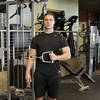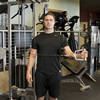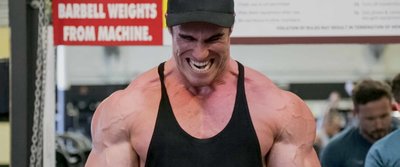Main Page | Get The PDF | 5 Steps To Elite Muscle Growth | Building Muscle In The Kitchen
Calum von Moger and elite bodybuilders like him often train in a way that looks random to the rest of us. And he admits that he doesn't always know exactly what he's going to do when he walks into the gym. But that's because the rules of muscle building are so engrained in him that he can basically follow them in his sleep.
Here's the good part: It's no mystery how he does it. Follow these five steps, and you can customize any workout for maximum growth. Then put them into action with the eight muscle-building workouts below, along with a meal plan from Kevin Alexander of FitMenCook!
Step 1 Do a warm-up specific to your split
Pretty much everything von Moger does follows a bodybuilding split that hammers just one or two body parts each day. This way of training works wonders for mass, but there's a catch: If you're going to push a body part to the breaking point, you need to prepare it first.
Chest Warm-up with Calum von Moger
Five minutes on the treadmill and a couple of warm-up sets may have seemed like enough when you were starting out, but the more experienced (and older) you get, the more you can benefit from body-part-specific warm-ups as well.
When von Moger is going to work his chest, for example, he never fails to include a specific warm-up. Here's how his looks:



BodyFit
$6.99/month- 2,500+ expert-created single workouts
- 3,500+ how-to exercise videos
- Detailed workout instruction
- Step-by-step workout tips
- Training at gym or at home
- Access to Workout Plans
- Access to Bodyfit App
- Store Discounts
Already have a Bodybuilding.com account with BodyFit? Sign In

What comes with BodyFit?

- Instructional Videos
Don't risk doing a workout improperly! Avoid injury and keep your form in check with in-depth instructional videos.

- How-to Images
View our enormous library of workout photos and see exactly how each exercise should be done before you give it a shot.

- Step-by-Step Instructions
Quickly read through our step-by-step directions to ensure you're doing each workout correctly the first time, every time.
Don't push these movements to the max. You're just warming up the target muscles, which can help you not only push more weight, but also maximize the crucial mind-muscle connection during the workout to follow. Von Moger says his routine just takes a couple of minutes. Don't skip it!
Step 2 Push serious weight in a multijoint movement you love
OK, you don't have to love the first movement in your workout, but you should at least feel confident enough to move decent weight with good form in a respectable range of motion. After all, this is when you're freshest, strongest, and—hopefully—most enthusiastic.
Calum loves to lead with the incline bench, a common choice among bodybuilders and competitors. You can delve into the pros and cons of flat versus incline as an overall chest builder—the latter has a greater range of motion and produces a bigger stretch, for instance—but ultimately, this is a question of taste.
Whatever comes next, build your workouts around exercises like presses, squats, deadlifts, and rows. Choose movements that you're strong in, so you can move some heavy weights. Any of these will do:
Foundation Exercises
- Chest: Incline, decline, or flat bench press
- Back: Bent-over row, deadlift, weighted pull-up
- Shoulders: Military press, dumbbell military press
- Legs: Squat, front squat
Step 3 Add volume and angles in the classic muscle-building range
There's nothing wrong with keeping reps relatively low, like 5-8 reps per set, in your first movement of the day. But if you do everything in your workout that heavy, well, you'll be parked on the bench resting for a really, really long time.
In the middle of your workout, go a little lighter, do a few more reps per set, and mix up things like grips, angles, and implements, while still favoring multijoint movements for the most part. If you started with the incline barbell bench, for example, the flat dumbbell press would provide a different stimulus and hit slightly different angles.
Aim for somewhere between 6-12 reps with good form, reaching muscle failure within that target range. For his part, von Moger prefers to stick with the lower end of the range, going no higher than 10. If a weight's too easy or too heavy, adjust it accordingly on your next set.
Because you're training in a slightly higher rep range for this work, you generally don't need to rest more than 90 seconds to two minutes. The more you go to or past muscle failure, the more you'll need to rest. That's why von Moger says he'll only push to failure or beyond on certain movements, usually toward the end of the workout.
Step 4 Perform a high-rep finisher that brings you to your knees
Moderate to heavy training like you've completed thus far causes small tears within the muscle fibers, which triggers a cascade of events leading to bigger and stronger muscles. That's how von Moger and bodybuilders from time immemorial have started their routines. He finishes it, on the other hand, with a different approach, which he calls "super finishers." These are all about generating an incredible pump at the end of your training session.
The back end of your workout is the perfect place for single-joint movements, which better isolate the muscle and create what is known as "metabolic stress." That means coming down in poundage, and usually, training in a slightly higher rep range, such as 12-15 reps. This rep target pulls fluids into the muscle as lactate accumulates, which contributes to the burning sensation you feel in the muscle being trained.
Von Moger prefers to use a double dropset at the end of his EZ-bar curls, a shock routine so intense that he can't even lift the bar by the end. To perform this, lift until you hit failure at around 12-15 reps, then drop the weight by about 30 percent and lift to failure again. Then, drop the weight and keep going to failure one more time.
Step 5 Find a training split that's right for you
A great workout is one thing. A great training week is another. If you set up your split wrong, you simply won't be able to sustain intensity over the course of four or more sessions. But with the right split, it's amazing what you can achieve.
The eight workouts we've designed below can be combined in any number of ways, allowing you to create a personalized training split that works for your own schedule and time constraints. These are two that I feel work best.
Two-on/one-off split
- Monday: Back, biceps, calves
- Tuesday: Chest, triceps, abs
- Wednesday: Rest
- Thursday: Quads/glutes, hams, calves
- Friday: Shoulders, abs
- Saturday: Rest
- Sunday: Cycle repeats
Five-on/Two-off split
- Monday: Chest, abs
- Tuesday: Back, calves
- Wednesday: Shoulders, abs
- Thursday: Quads/glutes, hams, calves
- Friday: Biceps, triceps
- Sat/Sun: Rest
8 Workouts and a Meal Plan to Put It All Together
With all you've read so far, you're qualified to build your own muscle-building workout, but you don't have to! We've designed no less than eight workouts to help you fill out the above splits. And just to sweeten the deal (which is free, by the way), we've thrown in a mass-building meal plan from Kevin Alexander of FitMenCook.
If you find that combining the workouts on the split makes your workouts too long or impedes your recovery, cut movements from the middle of the workouts. Keep the first multijoint movement and the finishers intact as best you can.
Use the tips above to help you customize the workouts and the meal plan to fuel them, and you'll be set for a long time. Happy growing!


